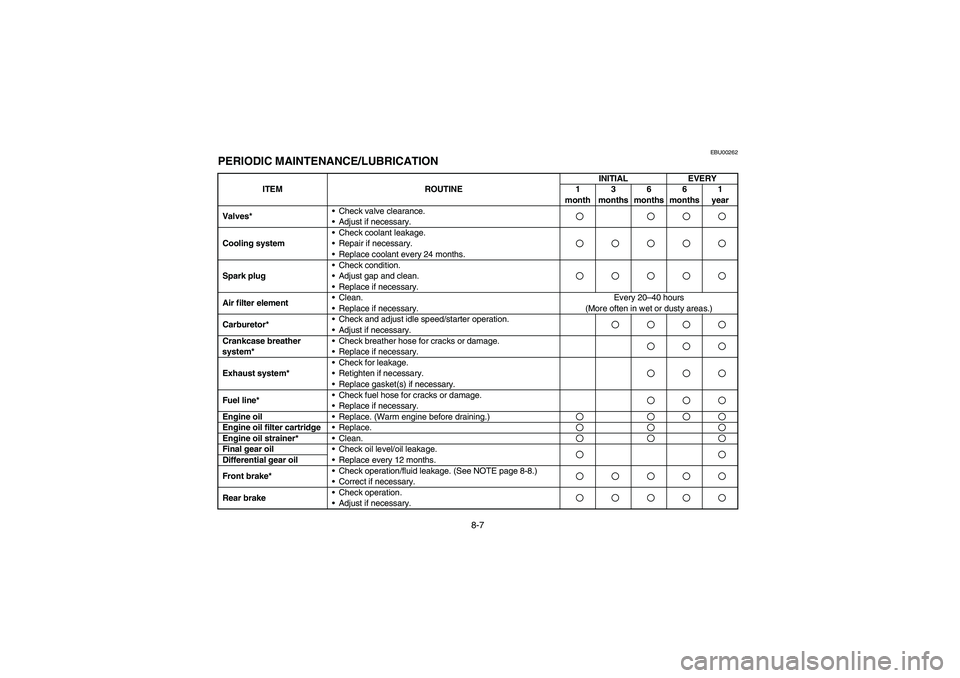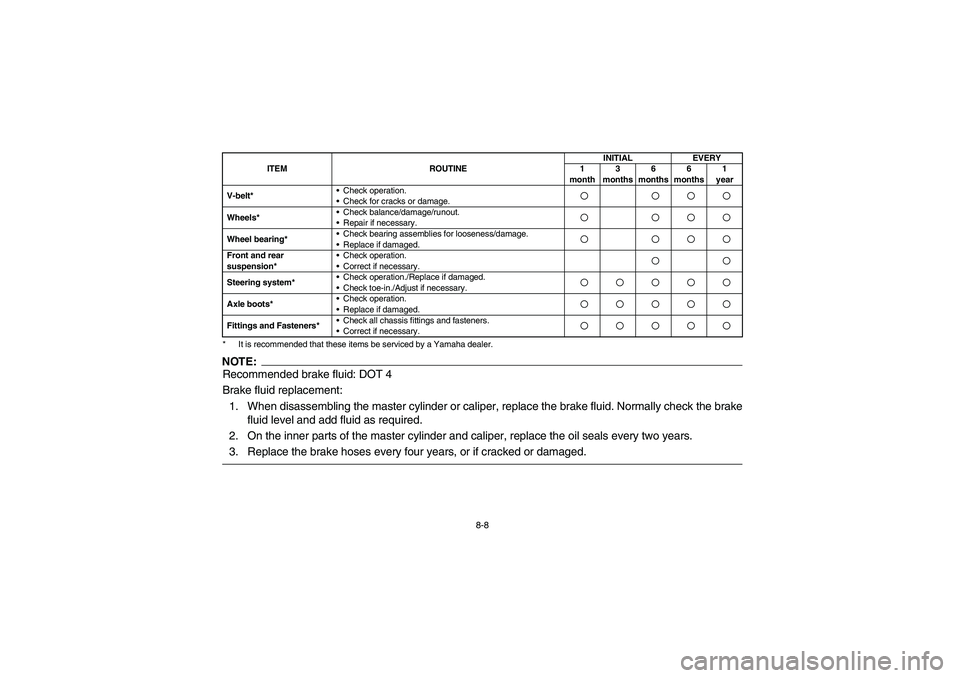Page 248 of 426
7-71
SLIDING AND SKIDDING
Care should be used when riding on loose or slip-
pery surfaces since the ATV may slide. If unex-
pected and uncorrected, sliding could lead to an
accident.
To reduce the tendency for the front wheels to
slide in loose or slippery conditions, positioning
your weight over the front wheels will sometimes
help.
If the rear wheels of your ATV start to slide side-
ways, control can usually be regained (if there is
room to do so) by steering in the direction of the
slide. Applying the brakes or accelerating is not
recommended until you have corrected the slide.
U5TE60.book Page 71 Monday, June 10, 2002 8:47 AM
Page 252 of 426
7-75
WHAT TO DO IF ...
This section is designed to be a reference guide
only. Be sure to read each section on riding tech-
niques completely.
WHAT TO DO ...�
If your ATV doesn’t turn when you want it to:
Bring the ATV to a stop and practice the turning
maneuvers again. Be sure you are putting your
weight on the footboard to the outside of the
turn. Position your weight over the front wheels
for better control. (See pages 7-39–7-43.)
�
If your ATV begins to tip while turning:
Lean more into the turn to regain balance. If
necessary, gradually let off the throttle and/or
steer to the outside of the turn. (See pages
7-39–7-43.)
�
If your ATV starts to slide sideways:
Steer in the direction of the slide if you have the
room. Applying the brakes or accelerating is
not recommended until you have corrected the
slide. (See pages 7-71–7-73.)
U5TE60.book Page 75 Monday, June 10, 2002 8:47 AM
Page 254 of 426
7-77�
If your ATV can’t make it up a hill you are trying
to climb:
Turn the ATV around if you still have forward
speed. If not, stop, dismount on the uphill side
of the ATV and physically turn the ATV around.
If the ATV starts to slip backwards DO NOT
USE THE REAR BRAKE - the ATV may tip
over on top of you. Dismount the ATV on the
uphill side. (See pages 7-45–7-53.)
�
If your ATV is traversing a sloping surface:
Be sure to ride with your weight positioned to-
wards the uphill side of the ATV to maintain
proper balance. If the ATV starts to tip, steer
down the hill (if there are no obstacles in your
way) to regain balance. If you discover that the
ATV is going to tip over, dismount on the uphill
side. (See pages 7-59–7-61.)
U5TE60.book Page 77 Monday, June 10, 2002 8:47 AM
Page 256 of 426
7-79�
If your ATV encounters shallow water:
Ride slowly and carefully through slow moving
water, watching for obstacles. Be sure to let
water drain from the ATV and CHECK YOUR
BRAKES FOR PROPER OPERATION when
you come out of the water. Do not continue to
ride your ATV until you have regained ade-
quate braking ability. (See pages 7-63–7-67.)
U5TE60.book Page 79 Monday, June 10, 2002 8:47 AM
Page 264 of 426

8-7
EBU00262
PERIODIC MAINTENANCE/LUBRICATION
ITEM ROUTINEINITIAL EVERY
1
month3
months6
months6
months1
year
Valves*•Check valve clearance.
•Adjust if necessary.
Cooling system•Check coolant leakage.
•Repair if necessary.
•Replace coolant every 24 months.Spark plug•Check condition.
•Adjust gap and clean.
•Replace if necessary.Air filter element•Clean.
•Replace if necessary.Every 20–40 hours
(More often in wet or dusty areas.)
Carburetor*•Check and adjust idle speed/starter operation.
•Adjust if necessary.Crankcase breather
system*•Check breather hose for cracks or damage.
•Replace if necessary.Exhaust system*•Check for leakage.
•Retighten if necessary.
•Replace gasket(s) if necessary.Fuel line*•Check fuel hose for cracks or damage.
•Replace if necessary.Engine oil
•Replace. (Warm engine before draining.)Engine oil filter cartridge
•Replace.Engine oil strainer*
•Clean.Final gear oil
•Check oil level/oil leakage.
•Replace every 12 months.Differential gear oil
Front brake*•Check operation/fluid leakage. (See NOTE page 8-8.)
•Correct if necessary.Rear brake•Check operation.
•Adjust if necessary.U5TE60.book Page 7 Monday, June 10, 2002 8:47 AM
Page 265 of 426

8-8
* It is recommended that these items be serviced by a Yamaha dealer.NOTE:Recommended brake fluid: DOT 4
Brake fluid replacement:
1. When disassembling the master cylinder or caliper, replace the brake fluid. Normally check the brake
fluid level and add fluid as required.
2. On the inner parts of the master cylinder and caliper, replace the oil seals every two years.
3. Replace the brake hoses every four years, or if cracked or damaged.V-belt*•Check operation.
•Check for cracks or damage.Wheels*•Check balance/damage/runout.
•Repair if necessary.Wheel bearing*•Check bearing assemblies for looseness/damage.
•Replace if damaged.Front and rear
suspension*•Check operation.
•Correct if necessary.Steering system*•Check operation./Replace if damaged.
•Check toe-in./Adjust if necessary.Axle boots*•Check operation.
•Replace if damaged.Fittings and Fasteners*•Check all chassis fittings and fasteners.
•Correct if necessary.
ITEM ROUTINEINITIAL EVERY
1
month3
months6
months6
months1
year
U5TE60.book Page 8 Monday, June 10, 2002 8:47 AM
Page 344 of 426
8-87 a. Wear limit: 1 mm
a. Limite d’usure: 1 mm
a. Límite de desgaste: 1 mm
1. Wear limit line 2. Wear indicator
1. Ligne de limite d’usure 2. Indicateur d’usure
1. Línea del límite de desgaste 2. Indicador de desgaste
EBU00312
Front brake pad inspection
Inspect the brake pads for damage and wear. If
the thickness is less than the specified value, have
a Yamaha dealer replace the pads.NOTE:The wheels need to be removed to inspect the
brake pads. See page 8-109 for removal proce-
dures.
EBU00313
Rear brake shoe inspection
A wear indicator is provided on the rear brake.
This indicator allows checking of brake shoe wear
without disassembling the brake. Apply the rear
brake and check the position of the indicator. If the
indicator reaches the wear limit line, ask a
Yamaha dealer to replace shoes as a set.
U5TE60.book Page 87 Monday, June 10, 2002 8:47 AM
Page 346 of 426
8-89 1. Minimum level mark
1. Repère de niveau minimum
1. Marca de nivel mínimo
FRONT
Avant
Delantero
EBU01185
Brake fluid level check
Insufficient brake fluid may let air enter the brake
system, possibly causing the brakes to become in-
effective.
Before riding, check that the brake fluid is above
the minimum level mark and replenish if neces-
sary. A low brake fluid level may indicate worn
brake pads and/or brake system leakage. If the
brake fluid level is low, be sure to check the brake
pads for wear and the brake system for leakage.
Observe these precautions:�
When checking the fluid level, make sure the
top of the brake fluid reservoir is level by turn-
ing the handlebars.
�
Use only the designated quality brake fluid.
Otherwise, the rubber seals may deteriorate,
causing leakage and poor brake performance.
Recommended brake fluid: DOT 4
U5TE60.book Page 89 Monday, June 10, 2002 8:47 AM